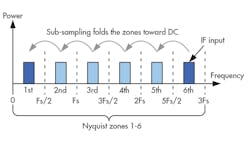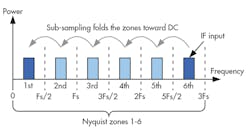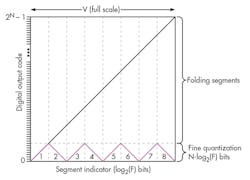Digital radios no longer dwell on the periphery of consumer electronics—in fact, they’ve been in the mainstream for quite some time now. Fundamentally, these transceivers use high-speed analog-to-digital converters (ADCs) and digital-to-analog converters (DACs) to replace the traditional baseband mixer stage. This architecture has many advantages because baseband conversion is done in the digital domain, allowing for much tighter filtering and adjacent channel rejection. If the ADC’s input bandwidth is high enough, it’s possible to downconvert directly in the ADC by undersampling the IF frequency (Fig. 1).
This is very common with digital receivers. However, preventing any energy from leaking into other zones requires a good-quality IF filter. Since this technique folds the energy in each zone back into the first Nyquist, there’s no way to discriminate the source. As a result, rogue energy appears in the first Nyquist zone, which degrades signal-to-noise ratio (SNR).
A similar reverse process can be implemented with high-performance DACs that contain a numerically controlled oscillator (NCO) and mixer. Along with interpolation, this process directly creates either the carrier or an IF signal that passes to a final upconverter stage. The signals remain in the digital domain much longer, which can improve SNR while simplifying the entire transceiver.
Spectrum Crowding
Radio-frequency (RF) spectrum, as with any commodity, comes at a premium. The Federal Communications Commission (FCC) periodically auctions spectrum and at times even “double farms” the land.
For example, many bands used for low-power communications, such as Bluetooth and IEEE 802.11, fall into the industrial, scientific and medical (ISM) band. The original ISM-band frequency allocations were used to prevent interference with telecommunications (radio) due to high-power RF heaters, microwave ovens, and other industrial equipment used for processing. The new allocation must share this spectrum with these existing industrial users. Thus, the FCC and other worldwide governing bodies limit the transmit power and require energy spreading by either frequency hopping or chipping (coding) the carrier.
Within a given band, techniques such as direct sequence spread-spectrum (DSSS) or frequency hopping can offer spectral diversity to improve the overall bit-error rate (BER). However, as the numbers of transceivers increase in a given area, it elevates the overall localized noise floor, once again degrading the SNR and leading to higher bit errors.
Use of spatial allocation through beam-forming allows for gains in both signal quality and channel capacity. This can be expanded to include spatial diversity in urban environments struggling with multipath issues. For instance, many residential Wi-Fi access points utilize spatial diversity to improve the multipath issues within a home. Also, many commercial-grade access points use beam-forming to improve Wi-Fi signal quality and limit access (for instance, only inside an establishment).
Cabled environments aren’t immune to the ever-increasing need for more capacity. Today’s modern cable systems utilize fiber and coaxial cables to deliver digital video, Internet access, voice over Internet protocol (VOIP), telephony, and a host of other services such as security and home automation. All of these services must rely on the existing infrastructure driving the development of new equipment. The humble set-top box is now a cable terminal that contains hundreds of man-years of engineering. Analog spectrum on cables is rapidly being reallocated for digital information in an effort to provide additional services.
Spectral issues even plague the government and military, both for sensing and communications. Secrecy is one important aspect of military operations, so keeping a low probability of intercept (LPI) or low probability of detection (LPD) becomes mandatory. This can be accomplished by spreading the energy wider along with the use of complex waveforms that mimic background noise. This improves LPI and LPD, but increases transceiver complexity by requiring a system that can capture the entire bandwidth at once.
This file type includes high resolution graphics and schematics when applicable.
“Need for Speed” Drivers
The applications and issues mentioned in this article all have one thing in common—the need to capture more bandwidth simultaneously. Wideband communications and sensing requires extremely high-speed data converters, also known as ultra-high-speed analog-to-digital converters (UHS-ADCs). These devices have sample rates starting at around 1 Gsample/s and beyond. Many UHS converters available today, such as Texas Instruments’ ADC12D1800RF, can sample at 3.6 Gsamples/s and maintain an analog input bandwidth of over 3 GHz.
A common application for UHS data converters can be found in the home—the cable DVR. Traditional DVRs use analog or digital tuners that provide a single channel output. Typically, when using two of these, it’s possible to watch one channel while recording another. Simultaneous recording of two shows limits viewing to only those shows without disrupting one of the recordings.
Using a broadband approach, the entire cable bandwidth can be captured with a single UHS data converter. Subsequently, the data can be processed by multiple digital tuners instantiated in an FPGA or custom CMOS device. A cable gateway function could provide a whole house DVR with the ability to record eight to 32 or more programs simultaneously.
Government applications often rely on the ability to communicate without revealing your location, or otherwise risking interception of that information. Both are driving new waveforms and methods of concealing an RF signature to improve LPI and LPD capabilities. One way involves frequency spreading, in which the waveform occupies a very wide band. Using this method allows a signal to be placed near the noise floor; thus, the signal can only be detected with processing gain at the receiver.
Wide-band digital receivers require fairly good dynamic range (10 to 12 bits), as well as a UHS-ADC at the front end to capture the entire bandwidth. After acquiring the band, an FPGA or other hardware can provide the processing gain to recover the original waveform. Adding spectral diversity along with forward error correction (FEC) can achieve an excellent BER.
How UHS-ADCs work
UHS-ADCs implement one of two major architectures: flash or folding. Both provide extremely low latency, which is important to sensing and military applications.
Flash converters use a large number of extremely high-speed comparators along with an R-2R resistor ladder. The output of these comparators forms a thermometer code that can be translated into gray- or binary-type codes. For years, this was the only way to implement an UHS-ADC that suffers from very high power consumption and high cost. To implement an n-bit ADC, a flash device would require 2N-1 comparators. Therefore, a flash device for a modern 12-bit UHS-ADC would require 4095 comparators, along with the logic to convert the thermometer code to binary. This ADC architecture requires on the order of tens of watts to run.
UHS-ADCs built with the folding architecture, often referred to as partial flash, use circuit techniques (special folding amplifiers) to fold the input’s dynamic range into portions that can be addressed by a much smaller number of high-speed comparators. For instance, a 12-bit folding converter might have eight folds along the input. This reduces the dynamic range to one-eighth of the original requirement. As a result, the converter’s flash section will use 512 high-speed comparators (for the nine least significant bits), and fold the input for the remaining three bits (Fig. 2).
However, one major issue arises with this technique—the folding creates distortion. It affects both the integral nonlinearity (INL) and differential nonlinearity (DNL) curves, ultimately degrading the effective number of bits (ENOB). To compensate for these problems, manufacturers have developed (and patented) techniques to calibrate out these nonlinearity issues, providing excellent dynamic range with very reasonable power numbers.
In applications where UHS data converters acquire the entire band at once, several parameters should be considered beyond the normal dynamic characteristics. One such parameter is called the noise power ratio (NPR), which is expressed as the ratio of the power in a quiet band (no signals) to that of an equal-width band that contains signals. It’s used in multi-carrier applications to understand the system’s effects on the channelized signals. For UHS-ADCs, this parameter is dominated by the quantization noise as well as the input-referred noise, giving the device a figure of merit that can be compared to theoretical limits.
What Lies Ahead?
With thousands of new cellular terminals coming on line, service providers are quickly running out of spectrum to provide tolerable service to their customers. However, beamforming and spatial diversity offer lots of promise in thinning out the crowded spectrum. In highly populated urban environments, cellular systems suffer from multipath issues and spectrum crowding. Cellular networks already use a form of sectoring to provide additional coverage. But, with advanced beamforming (and beam nulling), each user could have his/her own channel with full capacity—without re-engineering the phone.
For cable systems, the ability to record eight or more shows simultaneously at a reasonable implementation cost provides additional revenue to service providers, as well as improves the overall viewing and recording experience. Consumers regularly become frustrated with limited prime-time options because many programs air simultaneously.
Conclusion
With the demand for more bandwidth, ultra-high-speed ADCs are becoming more common in many applications. As manufacturers push the limits to higher conversion rates, new standards such as JESD204B are being employed to mitigate the routing issues that now challenge board layout designers by serializing the high-speed digital data. Today it is common to find 4-Gsample/s ADCs like the ADC12J4000 as catalog devices—and more, faster converters are on the way.
References:
ADC12D1800RF datasheet
ADC12J4000 datasheet
JESD2048 white paper
Richard Zarr is a technologist at Texas Instruments focused on high-speed signal and data path technology. He has more than 30 years of practical engineering experience and has published numerous papers and articles worldwide. He is a member of the IEEE and holds a BSEE from the University of South Florida as well as several patents in LED lighting and cryptography.
About the Author
Richard F. Zarr
Richard Zarr is a technologist at Texas Instruments focused on high-speed signal and data path technology. He has more than 30 years of practical engineering experience and has published numerous papers and articles worldwide. He is a member of the IEEE and holds a BSEE from the University of South Florida as well as several patents in LED lighting and cryptography.



